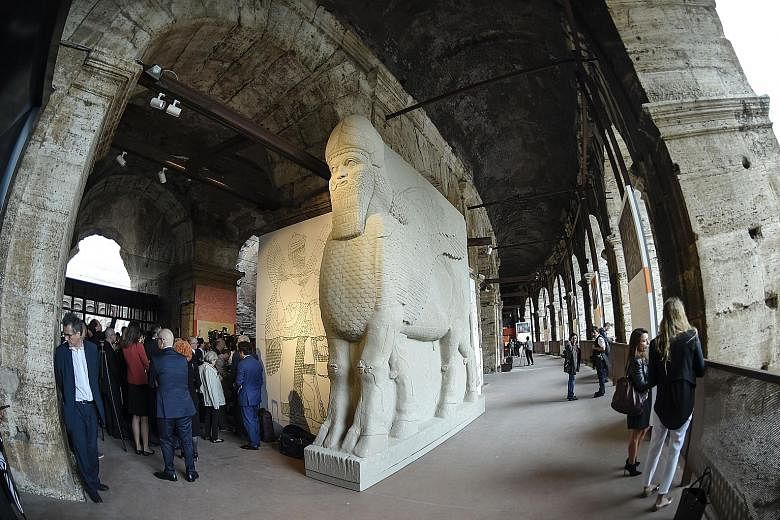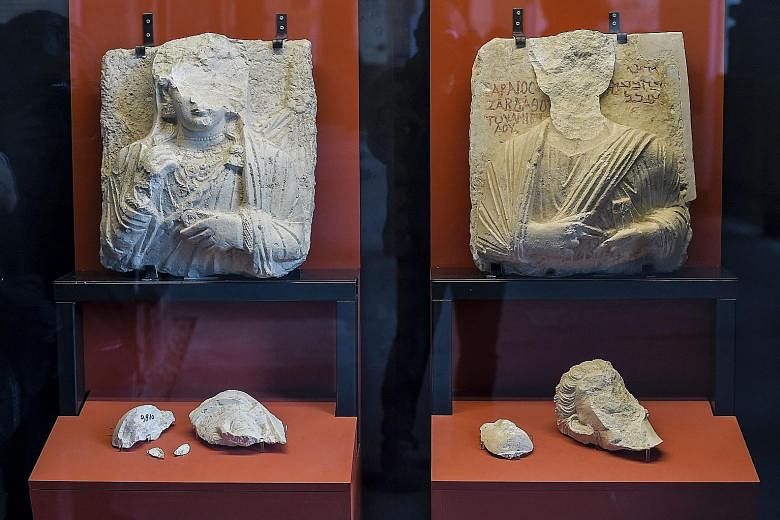ROME • A statue of a human-headed winged bull from the Northwest Palace in Nimrud, Iraq, which was bulldozed by the Islamic State in Iraq and Syria (ISIS) last year, has been faithfully recreated and put on exhibition at the Colosseum in Rome to spur discussion of the possible reconstruction of war-torn archaeological sites.
Full-scale reconstructions were also made of two damaged Syrian sites - the archive room of Ebla and a portion of a ceiling from the Temple of Bel in Palmyra - as examples of how conflict can devastate a nation's fragile heritage.
"Nimrud was the first place to be destroyed," said Ms Frances Pinnock, a member of the scientific committee for the exhibit and co-director of the Ebla expedition, the most important Italian archaeological expedition to Syria.
"It was a palace known as the Versailles of the ancient Near East, and so it was chosen because it was symbolic...
"We included Ebla because it represents abandonment, what happens to a site when a mission is no longer present to protect it."
She added that "Palmyra is a wound" and a place of violent murders, not just of Mr Khalid al-Asaad, the retired chief of antiquities for Palmyra, who was killed in August last year, three months after ISIS took the city, but also of the more than a dozen employees who were "killed in brutal ways only because they tried to protect the heritage".
Although the violence in the Middle East continues, archaeologists and officials from various international organisations continue to explore various options for the reconstruction of archaeological sites in Syria and Iraq once the fighting has abated.
The Ebla reconstruction was accomplished by a company based in Rome that specialises in film sets and props, while the Bel temple ceiling was recreated by a company in Ferrara that already works in casting copies.
Mr Francesco Rutelli, a former mayor of Rome and culture minister, and the driving force behind the exhibit, said the works recreated are not isolated objects but markers of a civilisation's "history, context and value" brought alive by "Italian know-how".
On display are also two marble busts from the museum in Palmyra that were damaged during the 10-month occupation by the ISIS terror group.
The badly damaged sculptures were brought to Italy, making an arduous journey from Damascus to Rome via Beirut, so that they could be restored.
"The only artefacts to leave Syria have been part of the illicit trafficking trade, but these came out with an accord," Mr Rutelli said.
Even though it is "very rare during a conflict that a corridor for culture opens", he said, cultural officials in Damascus had allowed the sculptures to travel because they knew the pieces would be in good hands, and on display in a prestigious spot where the plight of Syrian art would reach many.
Mr Francesco Prosperetti, the art official responsible for Rome's main archaeological area, said that the Colosseum - the most visited site in Italy - was chosen for maximum visibility.
"(It will give) a global message on the importance of cultural heritage and its value as part of national identity, on the need to protect it, preserve it, restore it and, in some cases, rebuild it," he said.
NYTIMES


